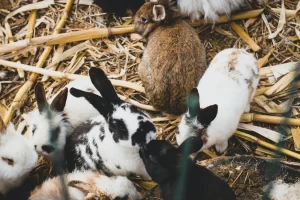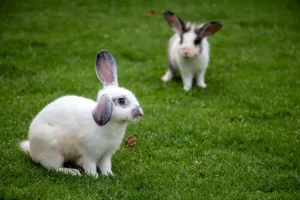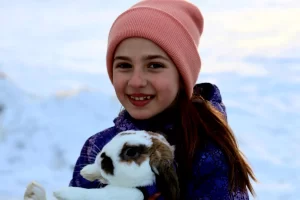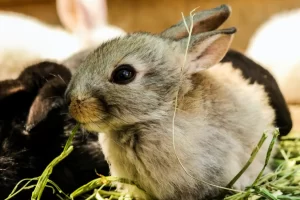Do you ever find yourself wondering how old your rabbit is? Like a detective, you can uncover clues to solve the mystery of their age. By examining their teeth, observing their growth stages, assessing their fur condition, and more, you’ll be able to estimate their age with confidence.
In this article, we’ll guide you through the process of determining your rabbit’s age, so you can better understand their needs and provide them with the care they deserve. Let’s dive in and become rabbit age detectives!
In This Article
- 1 Key Takeaways
- 2 Examining Teeth for Age Clues
- 3 Understanding Growth Stages in Rabbits
- 4 Assessing Fur Condition and Color
- 5 Observing Eye and Ear Development
- 6 Estimating Age by Body Size and Weight
- 7 Analyzing Mobility and Muscle Tone
- 8 Uncovering Clues in Behavior and Activity Level
- 9 Using Veterinary Assistance for Accurate Age Determination
- 10 Frequently Asked Questions
- 10.1 What Are Some Signs of Aging in Rabbits?
- 10.2 How Can I Determine the Age of a Rabbit if I Don’t Have Access to a Vet?
- 10.3 Are There Any Specific Behaviors That Indicate a Rabbit Is Older or Younger?
- 10.4 Can the Color of a Rabbit’s Fur Give Any Indication of Its Age?
- 10.5 Is There a Correlation Between a Rabbit’s Size and Its Age?
- 11 Conclusion
Key Takeaways
- Dental evaluation is crucial for accurately determining a rabbit’s age.
- Changes in size, sharpness, or wear of teeth can help estimate a rabbit’s age.
- Observing growth stages, such as eye and ear development, can provide insights into a rabbit’s age.
- Monitoring fur condition, body size, weight, mobility, muscle tone, social interactions, eating habits, and behavior can also help estimate a rabbit’s age.
Examining Teeth for Age Clues
You can determine a rabbit’s age by carefully examining its teeth for any age clues. The teeth of a rabbit can provide valuable insights into its age.
When a rabbit is young, its front teeth, called incisors, will be small and sharp. As the rabbit grows older, its incisors will gradually become longer and duller.
Additionally, you can estimate a rabbit’s age by looking at the wear and tear on its teeth. Older rabbits tend to have more worn down teeth compared to younger rabbits.
By examining the teeth closely and noting any changes in size, sharpness, or wear, you can make an educated guess about the rabbit’s age.
This information can be helpful in providing appropriate care and nutrition to the rabbit, as different age groups may have different dietary requirements.
Understanding Growth Stages in Rabbits
There are four main growth stages in rabbits, and each stage comes with its own unique characteristics and needs.
The first stage is the newborn stage, which lasts from birth to two weeks old. During this time, rabbits are completely dependent on their mother’s milk for nutrition.
The second stage is the weaning stage, which occurs from three to eight weeks old. At this point, rabbits begin to eat solid food and gradually transition from milk to a diet of hay, pellets, and fresh vegetables.
The third stage is the juvenile stage, which lasts from two to six months old. During this stage, rabbits experience rapid growth and require a diet rich in fiber, protein, and essential nutrients.
Finally, the fourth stage is the adult stage, which begins at six months old. Adult rabbits have specific nutritional requirements to maintain their health and prevent common health issues such as dental problems, obesity, and gastrointestinal issues.
It’s important to provide a balanced diet and regular veterinary check-ups to ensure the overall well-being of your rabbit.
Assessing Fur Condition and Color
To accurately assess the fur condition and color of your rabbit, carefully examine its coat for any abnormalities or changes, such as matting or discoloration, and feel the fur for texture and thickness. This will give you valuable insight into the overall health and well-being of your furry friend. When evaluating the fur texture, keep in mind that it should be soft and smooth, without any tangles or knots. Additionally, pay attention to the shedding patterns, as rabbits typically shed their fur twice a year.
Here are some key points to consider:
- Look for any signs of matting or clumping in the fur
- Observe if there are any changes in color or discoloration
- Feel the fur to determine its texture and thickness
- Note the shedding patterns and any excessive hair loss
- Regularly groom your rabbit to maintain a healthy coat
Observing Eye and Ear Development
Take note of the number of weeks it takes for your rabbit’s eyes and ears to fully develop. The development of a rabbit’s eyes and ears can give you clues about their age. Eye coloration and ear size can vary significantly between different stages of a rabbit’s life. Here is a table to help you understand the typical development timeline:
| Age (in weeks) | Eye Coloration | Ear Size |
|---|---|---|
| 1-2 | Closed, no color | Small, folded |
| 3-4 | Partially open | Slightly larger, unfolding |
| 5-6 | Fully open, no color | Larger, standing |
| 7+ | Eye color develops | Full size, erect |
Estimating Age by Body Size and Weight
You can estimate the age of your rabbit by observing its body size and weight. Here are some key indicators to help you determine the age of your furry friend:
- Body Condition: Assess the rabbit’s overall body condition, such as muscle tone and fat distribution. Younger rabbits tend to have a more slender and lean body, while older rabbits may have a more rounded or less muscular appearance.
- Weight: Monitoring your rabbit’s weight over time can provide insights into their age. Young rabbits tend to gain weight rapidly during their growth phase, while older rabbits may have a more stable weight.
- Growth Charts: Using growth charts specifically designed for rabbits can help you determine the approximate age of your rabbit based on their current size and weight.
- Teeth: Examining the rabbit’s teeth can also provide some indication of their age. Younger rabbits typically have smaller, sharper teeth, while older rabbits may have more worn down or discolored teeth.
- Temperament: Observing your rabbit’s behavior and temperament can offer clues about their age. Younger rabbits are often more energetic and curious, while older rabbits may be more calm and relaxed.
Analyzing Mobility and Muscle Tone
You can assess your rabbit’s age by observing their mobility and muscle tone, so pay attention to how they move and the condition of their muscles. Evaluating agility and flexibility, as well as measuring strength and endurance, are key factors in determining the age of your rabbit. Here is a table to help you understand the different characteristics that can indicate the age of your furry friend:
| Age Range | Mobility and Muscle Tone |
|---|---|
| 0-1 year | High energy, strong muscles, and quick movements |
| 1-3 years | Still energetic, good muscle tone, and agile movements |
| 3-5 years | Slightly slower movements, less muscle tone, and occasional stiffness |
| 5-8 years | Reduced mobility, decreased muscle tone, and signs of aging |
| 8+ years | Limited mobility, weak muscles, and increased stiffness |
Uncovering Clues in Behavior and Activity Level
To uncover clues about your rabbit’s age, pay attention to their behavior and activity level, as these can provide valuable insights. Rabbits, like humans, go through different stages of life, each with its own characteristics. Here are some key indicators to consider:
- Social interactions: Young rabbits are usually more active and playful, seeking interaction with other rabbits and humans. As they age, they may become more solitary and less interested in socializing.
- Eating habits: Young rabbits have a faster metabolism and tend to eat more frequently. As they mature, their eating habits may become more consistent and regulated.
Using Veterinary Assistance for Accurate Age Determination
If you want to accurately determine your rabbit’s age, consider consulting with a veterinarian and utilizing their expertise. Veterinary expertise is crucial when it comes to determining the age of your furry friend, as they have the professional knowledge and experience to accurately assess various factors.
A veterinarian will carefully examine your rabbit’s teeth, as dental changes can provide important clues about their age. They will also evaluate the rabbit’s overall health and physical condition, looking for any signs of aging or developmental milestones. Additionally, a veterinarian may use X-rays or other diagnostic tests to further assess your rabbit’s age.
Frequently Asked Questions
What Are Some Signs of Aging in Rabbits?
To estimate a rabbit’s age without a vet, look for signs of aging. These may include graying fur, decreased activity, dental issues, and weight loss. Keep an eye out for these changes as your rabbit grows older.
How Can I Determine the Age of a Rabbit if I Don’t Have Access to a Vet?
To estimate a rabbit’s age without a vet, observe its physical characteristics. Look at the color and condition of its teeth, fur, and eyes. Young rabbits have brighter eyes and softer fur, while older rabbits may have yellowed teeth and duller fur.
Are There Any Specific Behaviors That Indicate a Rabbit Is Older or Younger?
Specific physical traits can indicate a rabbit’s age, such as graying fur or reduced mobility. Additionally, you can estimate a rabbit’s age based on its behavior, such as increased sleepiness or decreased energy levels.
Can the Color of a Rabbit’s Fur Give Any Indication of Its Age?
You can’t judge a rabbit’s age by its fur color alone. While some rabbits may have graying fur as they age, it’s not a reliable indicator. Other factors like behavior and teeth condition are better clues.
Is There a Correlation Between a Rabbit’s Size and Its Age?
There is a correlation between a rabbit’s size and its age. Factors such as genetics, nutrition, and overall health can influence a rabbit’s growth rate, leading to variations in size among rabbits of the same age.
Conclusion
In conclusion, determining the age of a rabbit can be a fascinating endeavor. By examining their teeth, fur condition, eye and ear development, body size and weight, mobility and muscle tone, as well as their behavior and activity level, we can gain valuable insights into their age.
However, it’s always best to seek veterinary assistance for accurate age determination. Just like a detective unraveling clues, discovering a rabbit’s age can be a rewarding and satisfying journey.





